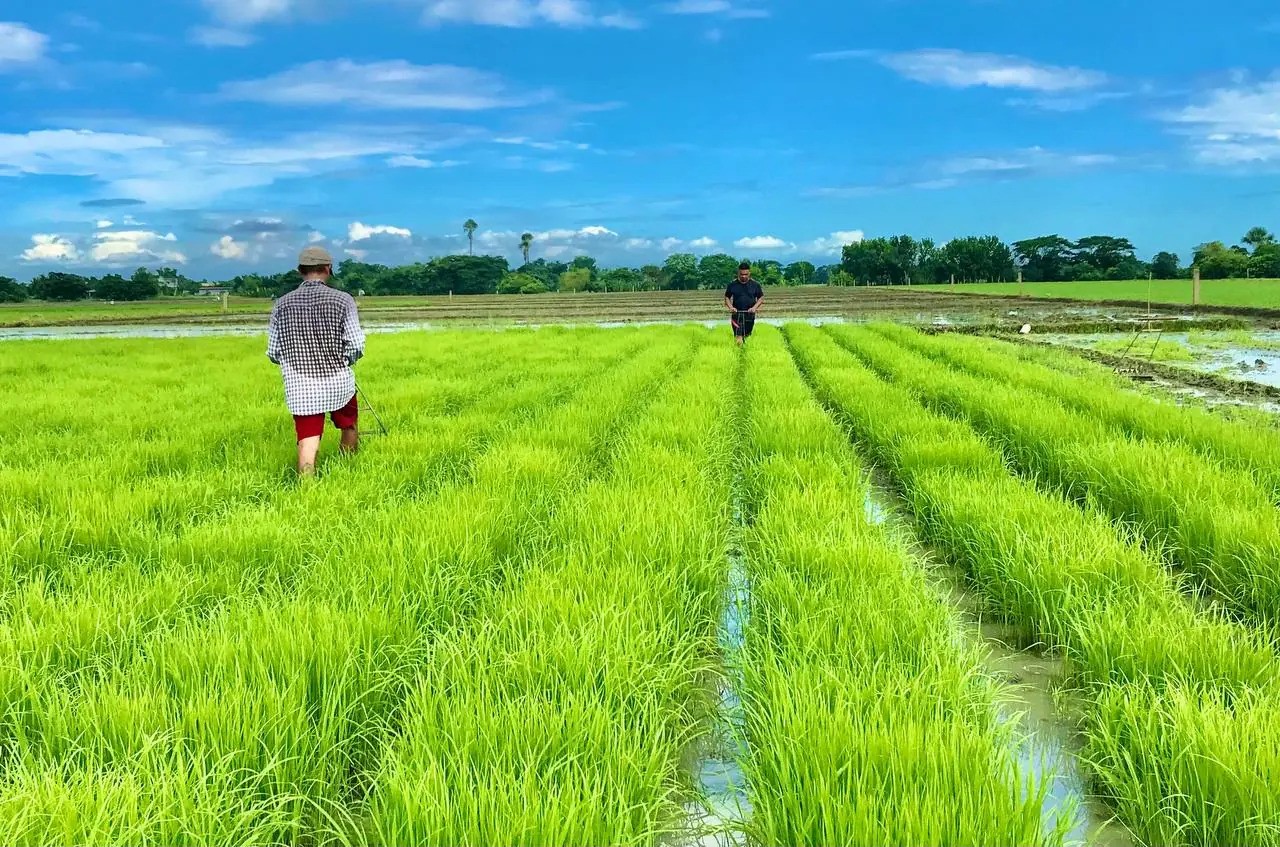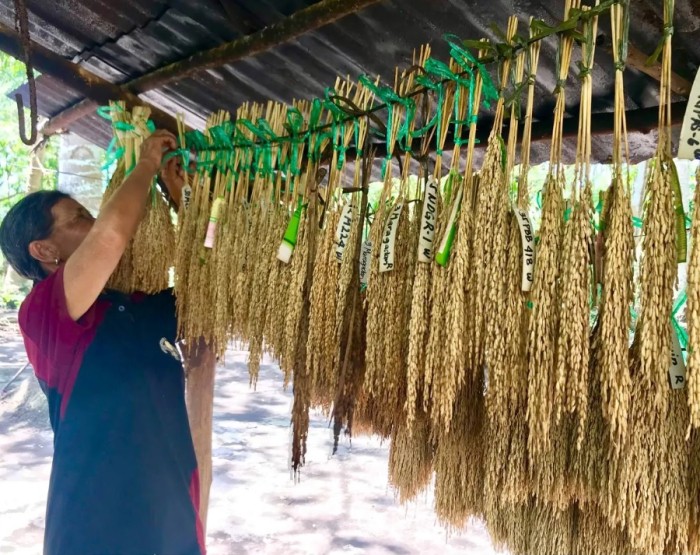Anti-pesticiden, pro-boeren: de opkomst van agro-ecologie
13 mar 2024

De Filipijnse rijstteelt, veruit de meest voorkomende in het land, lijdt nu al onder de klimaatverandering. Een stijgende zeespiegel, warmere temperaturen en extreme weersomstandigheden brengen de gewassen in gevaar. Droogte, overstromingen en oprukkend zout water bedreigen rijstvelden en dus ook de inkomsten van wie ze onderhoudt. Het internationale non-profit magazine Reasons to be Cheerful schreef daarover een interessant artikel, vertrekkend van het werk van onze Filipijnse partner MASIPAG.
MASIPAG is een groot nationaal netwerk waar zo’n 30.000 boeren en boerinnen deel van uitmaken. Zij zijn geëngageerd om ecologisch aan landbouw te doen. Al tientallen jaren kweekt MASIPAG inheemse rijstplanten om beter bestand te zijn tegen droogte, zout water, plagen en ziekten. Daarna verspreidde het netwerk onder zijn leden hoe ze deze veerkrachtigere variëteiten zelf konden telen met biologische teeltmethoden.

Het idee was om hen te helpen “de inheemse en lokale productieprocessen opnieuw te leren die bijna werden uitgewist door de Groene Revolutie”, zegt Kathryn Manga van de Asian People’s Exchange for Food Sovereignty and Agroecology (APEX), een koepel voor 26 organisaties, waaronder MASIPAG, uit 11 landen. De Groene Revolutie, die zich tussen 1960 en 1990 voltrok in tal van Aziatische, Sub-Saharaans Afrikaanse en Zuid-Amerikaanse landen, verving klassieke landbouwtechnieken door moderne technieken als genetische manipulatie en pesticidengebruik – praktijken die soms de honger verminderden, maar ook ecosystemen ontwrichtten en veel armoede veroorzaakte bij landbouwers.
De boeren in het netwerk van MASIPAG willen veelal terug naar de klassieke manier van werken, maar dan met veerkrachtigere planten. Het netwerk kweekt lokale rijstvariëteiten op eigenschappen van weerbaarheid tegen natuurrampen en de klimaatverandering. Toen in 2022 verschillende tyfoons het land teisterden, bleven tal van die variëteiten overeind ondanks de harde wind en regen.
MASIPAG is maar één voorbeeld van de groeiende mondiale beweging die met agro-ecologie de levensstandaard van landbouwers en hun praktijken verbetert.
Uit onderzoek en praktijkvoorbeelden zoals die van MASIPAG, blijkt dat agro-ecologie veelbelovend is voor zowel het versterken van boerengemeenschappen als voor natuurbehoud
Agro-ecologie – landbouw die meewerkt met de natuur – is vergelijkbaar met regeneratieve/herstellende landbouw, die zich richt op de gezondheid van de bodem, bijvoorbeeld door kunstmest en pesticiden te vermijden. Bij agro-ecologie zijn echter ook sociale, economische en politieke waarden van tel, zoals landrechten, open toegang tot zaden, eerlijke en humane arbeidsomstandigheden en duurzame levensstandaarden. Uit onderzoek en praktijkvoorbeelden zoals die van MASIPAG, blijkt dat agro-ecologie veelbelovend is voor zowel het versterken van boerengemeenschappen als voor natuurbehoud.
“Hoewel agro-ecologie tegenwind krijgt van beleidsmakers en vaak nog als hoogdrempelig wordt aanzien, heeft het een grote rol te spelen bij het tegengaan van klimaatverandering en de bevordering van klimaatrechtvaardigheid”, zegt Ernesto Mendez, hoogleraar Agro-ecologie en Milieustudies aan de Universiteit van Vermont. “Momenteel leren we aan de universiteit methodes aan om de klimaatverandering in te perken en hoe boeren zich eraan kunnen aanpassen, maar we willen ook lessen over sociale thema’s als gelijkheid en (klimaat)rechtvaardigheid integreren.”
Strijd voor boeren- en boerinnenrechten
“Voor gerechtigheid in de Filipijnen is een verregaande landbouwhervorming nodig, met vrije landverdeling”, zegt Manga van APEX. Ze kaart aan dat Filipijnse boeren worden vermoord omdat ze opkomen voor hun (land)rechten. “Alleen door hen de volledige controle te geven over hun akkers, kunnen ze zich wapenen tegen de klimaatcrisis.”
Met andere woorden: Manga wil dat de landloze boeren en boerinnen die op grote plantages werken, vaak onder onrechtvaardige omstandigheden, hun eigen land bewerken met behulp van agro-ecologische principes, wat volgens haar het beste antwoord is op de klimaatverandering. De Filipijnen hebben in 1988 een landbouwhervormingswet aangenomen, maar falen in de uitvoering ervan.

"Boeren zijn beter uitgerust dan multinationale zadenbedrijven om rassen te identificeren en te veredelen die in hun regio gedijen" - Lucil Ortiz (MASIPAG)
“Ook zadensoevereiniteit - de vrije uitwisseling van zaden tussen boeren - is een onderdeel van agro-ecologie en essentieel voor gerechtigheid”, zegt Lucil Ortiz van MASIPAG. Er zijn gesprekken gaande om de Filipijnse zadenwet te wijzigen zodat boeren niet langer zaden mogen veredelen en verdelen. Het participatieve rijstveredelingsprogramma van MASIPAG zou in elkaar stuiken. Ortiz: “Door arme boeren te dwingen de beperktere zaadvariëteiten van grote bedrijven te kopen, blijven ze in de schulden zitten, en het helpt hen niet bij het opbouwen van klimaatbestendigheid. Boeren zijn beter uitgerust dan multinationale zadenbedrijven om rassen te identificeren en te veredelen die in hun regio gedijen.”
Bewezen voordelen
Agro-ecologische landbouw is gericht op het herstel en behoud van organisch materiaal in de bodem. Ze maakt gebruik van gewas- en weilandrotatietechnieken, organische meststoffen zoals mest en compost, combineert bosbouw met landbouw en gebruikt gewasvariëteiten die zijn aangepast aan het klimaat.
Studies bewijzen dat agro-ecologie in vergelijking met de intensieve productie, chemische input en monocultuur van de conventionele landbouw, meer koolstof in de bodem kan vasthouden, minder water gebruikt, de afhankelijkheid van synthetische meststoffen en pesticiden vermindert en biodiversiteit bevordert. Ook zorgt agro-ecologie voor hogere inkomens voor boeren en een grotere voedselzekerheid.
Verder is aangetoond dat boerengemeenschappen die agro-ecologie beoefenen sneller herstellen van extreme weersomstandigheden, deels omdat ze georganiseerd zijn. Boeren en boerinnen in die gemeenschappen zijn verbonden met hulpbronnen en netwerken en ze helpen elkaar.(bron)

Uit ander onderzoek blijkt dan weer dat boerderijen die werken met biologische MASIPAG-rijstvariëteiten beter bestand zijn tegen klimaatverandering dan conventionele rijstboerderijen. De onderzoekers vergeleken nog 54 andere facetten van biologische tegenover niet-biologische landbouwsystemen, zoals huishouden, productie-opbrengst en andere ecologische, sociale en economische factoren. De biologische boerderijen scoorden logischerwijs beter op ecologie, maar ook op sociale indicatoren als de gezondheid van huishoudens, de kennis van strategieën voor landverbetering, toegang tot infrastructuur, actieve groepsparticipatie en investeringen in menselijk kapitaal, zoals opleidingen.
Ook het vermogen van agro-ecologie om de klimaatverandering in te dijken werd recent onderzocht door 80 agro-ecologische studies samen te brengen. De onderzoekers vonden “sterk bewijs dat agro-ecologische benaderingen een hoge productiviteit en winst kunnen bereiken zonder de externe milieueffecten van de conventionele landbouw”.
All about the money
"De toepassing van agro-ecologie op grote schaal wordt veelal belemmerd door overheidsbeleid en privéinvesteringen, die neigen naar industriële landbouw en biotechoplossingen", zegt Daniel Moss, codirecteur van Agroecology Fund. Het fonds geeft subsidies aan agro-ecologische bewegingen wereldwijd. Toch ziet Moss vooruitgang, zoals de oprichting van de Agroecology Coalition, dat filantropen, overheden, privéinvesteerders en donororganisaties samenbrengt om een mondiale transitie naar agro-ecologische voedselsystemen te ondersteunen. De leden van Agroecology Coalition beheren een databank van investeringen en zorgen ervoor dat gefinancierde projecten klimaatgunstige landbouw combineren met sociale gelijkheid.
Het huidige systeem faalt: 783 miljoen mensen wereldwijd hebben chronisch honger
“De industrie zegt dat de agro-ecologische ideeën te romantisch zijn en dat we hun technologie nodig hebben om de miljoenen mensen die honger lijden te voeden”, zegt Helda Morales, senior onderzoeker bij El Colegio de la Frontera Sur in Mexico. Maar Morales draait dat om en merkt op dat het huidige systeem nu al faalt: 783 miljoen mensen wereldwijd hebben chronisch honger. Ze wijst op onderzoek dat bewijst dat het opschalen van agro-ecologie op landelijk of regionaal niveau genoeg voedsel kan produceren om alle mensen te voeden, met het voorbehoud dat we allemaal meer plantaardig eten.

Daniel Moss van Agroecology Fund vult aan: “Het zwaar gesubsidieerde industriële landbouwsysteem is pas 150 jaar oud, wat eigenlijk heel jong is in de geschiedenis van de landbouw. Is het met al het bewijs dat agro-ecologie de voeding, het landschap en de inkomens van boeren verbetert geen tijd voor een koerswijziging?”
Voor Manga is de koers duidelijk. “Lokale kennis samen met wetenschappelijke inzichten zijn het bewezen antwoord op de klimaatcrisis op het platteland”, zei ze. “Zij die in de frontlinie staan van de gevolgen van de klimaatverandering, hebben de oplossing. Het is aan hun regeringen om naar hen te luisteren en hen te steunen in hun inspanningen.”






